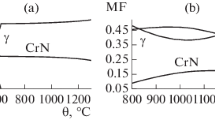Abstract
We show that surface saturation with carbon from a special technological environment increases the microhardness of the hardened layer on low-carbon steels up to 8–12 GPa. We established an increase in the wear resistance of the white layer by a factor of 1.3–1.5.
Similar content being viewed by others
References
Yu. I. Babei,Physical Foundations of Pulse Hardening of Steel and Pig Iron [in Russian], Naukova Dumka, Kiev (1988).
V. M. Golubets, “Dependence of the wear resistance of the white layer on the carbon content in steel,”Fiz.-Khim. Mekh. Mater.,9, No. 1, 105–106 (1973).
M. D. Maksimishin,Structure-Phase Changes during pulse Hardening of Steel and Their Influence on the Serviceability of Machine Elements [in Russian], Author's Abstract of the Candidate Thesis (Technical Sciences), L'viv (1986).
V. I. Kyryliv,Development of the Method of Surface Alloying of Steels under Mechanical-Pulse Treatment [in Ukrainian], Author's Abstract of Candidate-Degree Thesis, L'viv (1997).
M. E. Gurevich, L. N. Larikov, A. E. Pogorelov, and V. M. Fal'chenko, “Effect of pulse laser irradiation on the mobility of atoms in metals,” in:Effect of the Defects of Crystalline Structure on Diffusion in Metals and Alloys and Mass Transfer under Pulse Action [in Russian], Preprint No. 13, Inst. of Physics of Metals, Ukr. Acad. Sci., Kiev (1980), pp. 35–36.
T. P. Seroshtan, “Intensification of the processes of diffusive saturation of steels in polymeric environments,” in:Protective Coatings on Metals [in Russian], Issue 23, Kiev (1989), pp. 4–8.
I. É. Vinogradova,Antiwear Additives to Oils [in Russian], Khimiya, Moscow (1972).
V. N. Latyshev,Increase in the Efficiency of Lubricants-Coolants [in Russian], Mashinostroenie, Moscow (1975).
V. I. Kyryliv, T. N. Kalichak, and Yu. I. Babei,A Device for Hardening of External-Cylindrical Surfaces of Articles [in Russian], USSR Author Certificate No. 1199601, IPC4: I24I 39/04, Publ. 23.12.85, Bull. No. 47 (1985).
T. N. Kalichak, V. I. Kyryliv, A. I. Soshko, et al.,A Method for Hardening the Surface of Products [in Russian], USSR Author Certificate No. 1678858, IPC5: C21D 5/00, C23C 8/00, Publ. 23.09.91, Bull. No. 23 (1991).
D. S. Gertsriken, V. F. Mazanko, and V. M. Fal'chenko,Pulse Treatment and Mass Transfer in Metals at Low Temperatures [in Russian], Naukova Dumka, Kiev (1991).
L. N. Larikov, V. M. Fal'chenko, V. F. Mazanko, et al., “Anomalous acceleration of diffusion under pulse loading of metals,”Dokl. Akad. Nauk SSSR,221, No. 5, 1073–1075 (1975).
D. H. Buckley,Surface Effects in Adhesion, Friction, Wear, and Lubrication, Elsevier, Amsterdam (1981).
L. I. Tushinskii,Theory and Technology of Hardening of Metal Alloys [in Russian], Nauka, Novosibirsk (1990).
Additional information
Karpenko Physicomechanical Institute, Ukrainian Academy of Sciences, L'viv. Translated from Fizyko-Khimichna Mekhanika Materialiv, Vol. 35, No. 6, pp. 88–91, November–December, 1999.
Rights and permissions
About this article
Cite this article
Kyryliv, V.I. Surface saturation of steels with carbon during mechanical-pulse treatment. Mater Sci 35, 853–858 (1999). https://doi.org/10.1007/BF02359467
Received:
Issue Date:
DOI: https://doi.org/10.1007/BF02359467




